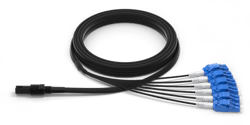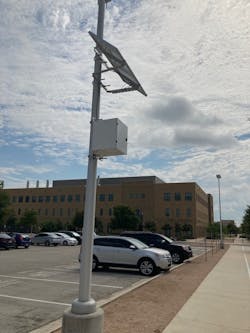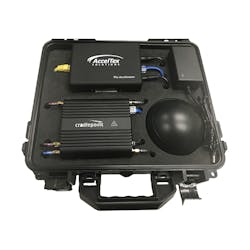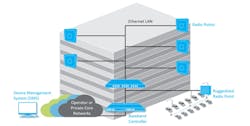With 5G deployments underway, challenges and opportunities will come
Deployments of 5G—the 5th generation of mobile networks—are just starting to roll out across the nation with the promise of 10 times faster speeds and the ability to support 10,000 times more network traffic and 100 times more devices than 4G, all with one-fiftieth the latency that offers near real-time data transfer for emerging applications. While 5G is expected to improve the consumer experience and evolve mobile streaming, content delivery, and other online consumer services, it goes way beyond smartphones and in-home entertainment to open the door for new business opportunities across every vertical market—from automotive and manufacturing, to healthcare, education, transportation and logistics, finance, retail, agriculture, and more.
The likes of AT&T, Verizon, T-Mobile, and other mobile carriers will undertake new 5G deployments and upgrades at the macrocell level to provide consumer coverage to wider areas, but the deployment of small cells (or microcells) deployed closer to data sources and users will be the backbone of 5G. While still in the initial stages, urban small cell deployments now make up the bulk of mobile carrier 5G plans, and the small cell market is predicted to grow at an unprecedented rate of more than 50% in the next five years.
While outdoor 5G small cells—both public and private—will be required to bring the 5G experience to consumers and support everything from smart city applications to connected vehicles, enterprise businesses will also need to leverage indoor small cell solutions and distributed antenna systems (DAS) to bring 5G into office buildings, factories, hotels, hospitals, airports, classrooms, and other venues. When it comes to the infrastructure to support 5G, from the macro and micro level to the inside premises, there will be a variety of challenges and potential opportunities.
The macro-micro divide
5G is fundamentally different than 4G in that it uses higher frequency to carry more data over shorter distances. In other words, more towers are needed to cover the same amount of space and number of users. That’s where small cells come in. Small cells work in conjunction with the more than 200,000 macrocell sites that exist across the nation—those large, high-power towers you see located along highways and in rural areas that provide low-frequency coverage for large areas. While existing challenges for macrocell deployment surrounding rights of way, weather conditions, lack of skilled labor, and cost (a macrocell deployment typically costs about 20 times more than a microcell) remain, much of the supporting fiber infrastructure exists.
“Backhaul infrastructure is important for macrocells but much of the fiber is already in place to these cell sites and advancements in optical transmission enable getting more bandwidth out of that fiber,” says Baber Abbas, CEO of viaPhoton, a provider of fiber-connectivity products. “The bigger issue at the macro level is power. There is a cost associated with every cable that goes up the tower, so rather than adding more cables, carriers are upsizing their wires to carry more power, which means tower operators have to worry more about weight and wind loading.”While macrocells will remain a major component of 5G networks, and thousands more are projected to be built, the numbers pale in comparison to small cell projections. Mobile carriers like Verizon and AT&T are expected to deploy 10 times more small cells than macrocells in the next five years. At the small cell level, having a 10-fold increase in the density of antennas poses different challenges and will certainly demand more fiber backhaul and infrastructure investment.
“Microcells do not require as much power as macro sites, and power is typically readily available from a local utility. Fiber on the other hand needs to be brought to the microcell pole, while fiber counts are going up at the same time. It is heavy lifting to design and deploy new infrastructure, so providers need to get more creative with existing fiber through advancements like bidirectional optics and wavelength division multiplexing,” says Baber. “Deployment at the micro level also means dealing with local jurisdiction and various requirements on what type of structure can go where.”
To reduce the need for new fiber deployments, many small cells will leverage existing metro FTTX infrastructure originally built for homes and businesses. Many small cell deployments are using legacy connectivity, such as Corning’s hardened OptiTap and OptiTip connectors long deployed by Verizon for FTTH deployments.
“While 5G is a global standard, the implementation can vary from one wireless operator to another. Because they are splitting out much of their existing fiber backhaul to support 5G, Verizon is using the same connectivity they used for FTTH. Others might take advantage of ODC [outdoor connector] or MPO [multi-fiber push-on] connectivity,” says Nathan Benton, VP of sales for viaPhoton that offers LC, MPO, ODC equivalent, OptiTip, and OptiTap connector options for their outdoor 5G-targeted fiber cables and connectivity. “Regardless of the connectivity, outdoor microcells are going to need protection against the elements with weatherized connectivity and IP68-rated housing.”
Powering and protecting outdoor cells
When it comes to powering outdoor small cell solutions, they can leverage existing local power when available, such as power used for city light poles, utility poles, and traffic lights. With less power required compared to macrocells, some small cells may also leverage solar power. Backup power is also a key consideration for any mission critical deployments.
“Active equipment that uses cellular backhaul needs power, and 5G small cells that are off grid present a unique challenge. That’s where solar is ideal. It could be a remote small cell in a state park to monitor vehicles coming in and out, or a deployment in a field to transmit data from agriculture sensors,” says Glenn Kierstead, director of business development for AccelTex, a Hubbell company that engineers and manufactures products and accessories for wireless networks. “We also see solar being used to power temporary remote mobile solutions for events like golf tournaments or for emergency response in hurricane- or tornado-damaged areas where there is often no power and cellular is the only available means of communication.”
In addition to power, those deploying outdoor small cells deployments will be challenged with protecting active equipment from the elements. Aesthetics, security, surge protection, and mounting are all considerations. Deployment in parks, parking lots, and other public and outdoor areas may require enclosures that protect equipment from environmental elements and tampering, including bollards, pole-mounted enclosures, and in-ground enclosures designed to be buried.
“Whenever you put any equipment outside, you need to protect it from the elements and provide lightning and surge suppression. Security is also consideration, as well some customers not wanting the technology to be visible,” says Chris Marco, director of brand management for AccelTex. “How the signals need to be propagated, the density it needs to support, and if it’s a directional or omnidirectional antenna can also dictate how a solution needs to be mounted.”
Bringing coverage indoors
While outdoor small cells are typically seen as a source of revenue, indoor cellular solutions that have been around for many years are needed to support the nearly 80% of mobile traffic taking place indoors and emerging business-critical 5G applications. And while in-building penetration issues aren’t new, the ability of 5G’s higher-frequency radio waves to penetrate building materials is worse than 4G.
“Even though there is a learning curve to figure out the best way to deploy indoor 5G coverage and integrate it into existing networks, there are key verticals like manufacturing and the military already exploring the technology for machine-to-machine communication and augmented and virtual reality for industrial automation and training,” says Luigi Tarlazzi, director of product management for CommScope’s DAS and small cell business. “There is also the need to evaluate cellular versus WiFi based on the needs of the application. The key driver is mobility, but it’s also about quality of service and latency. With the licensed spectrum of cellular, you can guarantee higher service level agreements and allow devices to respond much quicker with no interruption.”5G is especially top of mind among enterprise companies that already have an indoor cellular solution, with many wondering what will be required to upgrade existing 3G and 4G LTE systems. While some modular systems can be upgraded to support new 5G frequencies, it really depends on the system. “Enterprise customers will need to determine if the footprint they have for current 4G LTE is applicable to what they’ll need for 5G. Depending on what’s already installed, they may need to change radios, upgrade software, or overlay the system with new antennae to support the spectrum,” says Tarlazzi. “They also may need to densify to avoid coverage gaps, but that depends on what the target coverage is and what is required for the application.”
Those looking to deploy new indoor solutions also face the challenge of choosing between individual small cells and DAS where many nodes connect to function as a single cell. Small cells typically each require their own backhaul connection, while DAS only needs one backhaul. In general, small cells are considered more cost-effective for smaller facilities that don’t see large spikes in traffic, while DAS can be deployed to support more users and higher capacity.
“It really depends on the use case, and both small cells and DAS—even deployed together—can be ideal solutions for 5G,” says Tarlazzi. “Our ONECELL small cell solution is targeted mainly to small-to-large enterprises, while our DAS solution is more targeted to large public venues like stadiums and arenas. Both solutions leverage Ethernet transport and both copper and fiber structured cabling. We believe it’s important for in-building cellular to be as IT-friendly as possible.”
Opportunities arising
As 5G small cell deployments start to roll out, most industry experts anticipate plenty of opportunity for designers, integrators, and installers to get involved –working with either municipalities or enterprises looking to leverage the technology for public and private uses, either outdoors or indoors.
“5G will be a huge catalyst for in-building cellular market, as it opens up a variety of new use cases for cellular technology beyond mobile broadband. In order to make network deployments scalable, there is the need for a strong ecosystem of vendors, partners, and solution providers that can deliver these solutions to the end customer,” says CommScope’s Tarlazzi.Marco of AccelTex sees the deployment of 5G among enterprise customers, and its complementary evolving WiFi technology, as providing increased opportunity to individuals designing the network based on the coverage profile and to those that will be deploying the infrastructure and actually mounting the solutions. “From the standpoint of private 5G in stadiums and on campuses, there is plenty of opportunity for installers, while more public applications and smart city opportunities will go to high-end service provider contractors,” he says. “With 5G, there will likely also be a lot of opportunity for custom work that will leverage our integration side of the business to deliver turnkey solutions for specific use cases.”
AccelTex’s Kierstead also envisions that 5G will give complementary WiFi applications a boost and provide even more opportunity. “Carriers are going to want to offload a much as they can onto WiFi, and it doesn’t make sense for every device to connect directly to cellular. With new standards like WiFi 6 and 6E, and long-range, low-power WiFi HaLow, companies will build out mesh WiFi networks that can then use 5G cellular for the backhaul.”
As viaPhoton’s Benton points out, 5G also offers opportunity for data center professionals. “5G opens significant opportunities for OSP designers and installers, especially working with municipalities deploying fiber infrastructure to leverage the technology for remote learning and smart city applications. We’re going to eventually see a lot of 5G wirelessly connected devices outside of buildings because of the many advantages of mobility, and it’s far cheaper than connecting all those devices with wires,” says Benton. “With many of the applications supported by 5G, like machine-to-machine communications, autonomous vehicles, and smart traffic systems where latency becomes significant, it’s also going to be about how to get compute happening closer to the user and enabling faster access to the core, and someone is going to have to build the edge data centers to support that.”
About the Author

Betsy Conroy
Betsy Conroy has spent the past three decades writing quality technical content and leveraging that content to launch impactful integrated marketing campaigns. She started her career as a technical and promotional writer for medical, security, and environmental corporations. In early 2000, she became an independent freelance writer, editor, and content consultant, focusing primarily on B2B manufacturers and associations in the electrical, networking, and telecommunications industries. Betsy frequently publishes content in a variety of industry publications on behalf of her clients and is also a contributing writer to Smart Buildings Technology Magazine. She was previously a monthly contributing writer to Cabling Installation & Maintenance Magazine and chief editor of BICSI News Magazine for five years where she was instrumental in bringing the publication from a newsletter status to that of a preeminent trade magazine and helping to launch BICSI’s premier publication, ICT Today.




